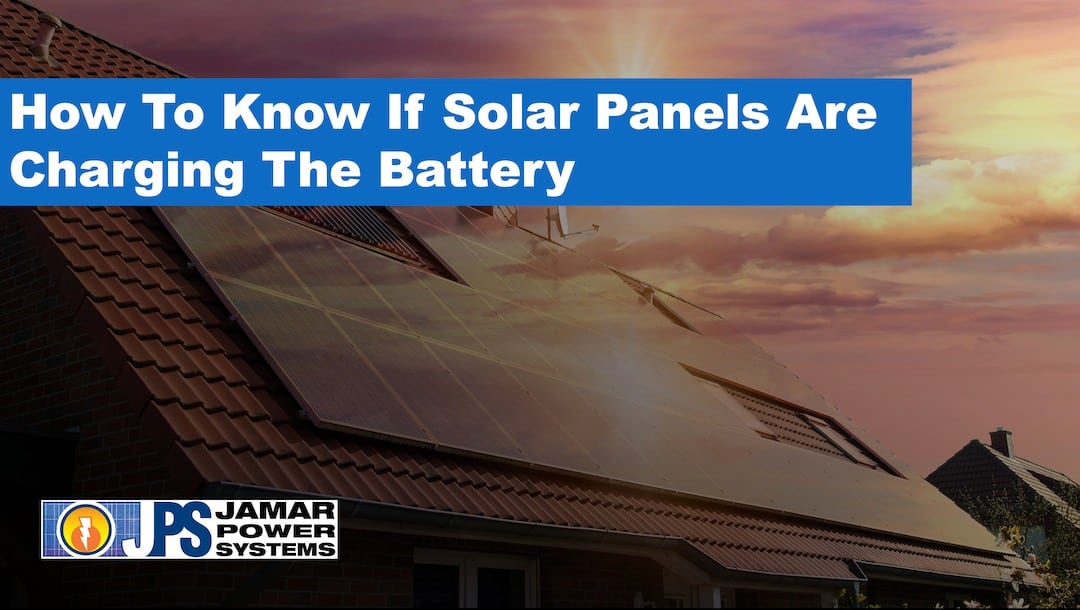How To Check If Your Solar Panels Are Charging The Battery
Hey there, San Diego homeowners!
Today, we’ll investigate an essential aspect of your solar energy storage system – checking if your solar panels are charging the solar battery.
Understanding Your Solar Energy System
Before we dive in, let’s quickly recap how your solar energy system works.
Sunlight hits your solar panels and gets converted into electricity.
The inverter converts the direct current (DC) electricity generated from the solar panels into the alternating current (AC) that powers your home.
This electricity can either be used immediately or stored in your battery for later use.
The charge controller regulates battery charging and prevents overcharging.
The solar battery stores all excess energy the solar panels produce that the household does not use immediately.
It’s important to note that different types and models of solar inverters, panels, and batteries have varying requirements for optimal function.
So, be sure to familiarize yourself with the specific needs of your system components to ensure it operates as intended.
Each component must be in top-notch condition for your system to work at its best. That’s exactly what we’re here to help you ensure.
How to Check if Solar Panel is Charging Battery
The first place to check is your solar energy system’s smartphone app if one was provided upon installation. These apps provide real-time system performance data.
It’s also a good idea to visually check your solar panels. Are they clean and getting enough sunlight? Is there shade covering them?
For peace of mind, click here to see our worry-free Real-Time Solar Monitoring & Alert Service for only $5 per month!
Check The Central Inverter For System Information
You might encounter two types of inverters in a residential solar system: standalone central inverters or microinverters on each panel.
Central inverters, often called string inverters, function as a single unit typically installed near your electrical panel. They take the combined DC power from all your solar panels and convert it into AC power for use in your home or to feed back into the electric grid.
Conversely, microinverters are small devices attached directly to each solar panel, converting the DC power to AC power at the individual panel level. This allows each panel to operate independently, ensuring that if one panel underperforms, it doesn’t impact the efficiency of the other panels.
Many central inverters have an LED display window or even a smartphone app that provides valuable real-time data about your system’s functionality.
These displays can show the amount of electricity produced, the energy consumed by your home, and the energy sent back to the grid.
They can also alert you to any faults or issues within the system. For instance, if your solar panels are not charging the battery efficiently, the inverter may display a fault code or warning light.
Some advanced models provide troubleshooting steps or suggest maintenance tasks.
Regularly checking these indicators can help you ensure that your solar panel system is operating optimally and allow you to address any potential issues promptly.

Why Is My Battery Not Charging From My Solar Panel?
If everything checks out so far, then it’s time to check the batteries.
There are generally three types of solar batteries: gel, lead-acid, and Lithium-based.
Most Lithium-based batteries come with a display panel showing the operating state, charge level, and any error codes. This makes it straightforward to check their status. Consult your owner’s manual for the display guide and error code definitions.
For gel, also known as Valve Regulated Lead Acid (VRLA) batteries, or lead-acid batteries, look for signs of corrosion or loose connections. A digital multimeter can also test their charge (following safety guidelines).
If your panels, inverter, and battery seem fine, the issue could lie with your charge controller.
How Do I Know If My Solar Charge Controller Is Charging?
The solar charge controller is the unsung hero of your solar energy storage system. It regulates the voltage and current from your panels and inverters to your battery. But how can you tell if it’s doing its job?
The charge controller is built-in to most lithium batteries, so consult your battery owner’s manual on how to check the display for operations and errors.
For charge controllers that are part of a gel or lead-acid battery backup system, first, pay attention to the LED indicators on the controller. Different codes, colors, and blinking patterns can tell you a lot about what’s happening. Check your manual to understand what each signal means.
If your controller isn’t charging, it could be due to several reasons. There may be a loose connection, or the controller itself is faulty.
How to Repair Solar Panel, Battery, or Inverter Faults
Safety first! Always shut down and disconnect your system before attempting any repairs.
For solar panels, cleanliness is usually the main concern. A quick clean can often solve any issues.
When it comes to batteries, gel and lead-acid ones may show signs of corrosion or have loose connections. If they’re old or damaged, consider replacing them.
As for charge controller or inverter issues, start by checking for loose connections. If everything seems connected but the problem persists, it’s time to call in the professionals.
Wrapping Up
Solar energy systems are fantastic, but they require some TLC. Annual safety inspections and timely repairs ensure your system works efficiently, keeps your home powered up, and saves you money.
If you’re dealing with suspected or persistent issues, don’t hesitate to reach out to us at Jamar Power Systems. Our team of experts is always ready to help San Diego homeowners keep their solar energy systems running smoothly.
Call our team at Jamar Power Systems today at (619) 448-7770 if you need any help with your solar energy or battery storage systems.
Related articles:
2025 Federal tax credit changes for solar & solar batteries
Solar panel monitoring service
Battery storage system fundamentals
Peak Shaving: Invest in your home’s energy future for significant ROI
Why a battery makes financial sense with solar panels now under NEM 3.0
How long will a solar battery last during a power blackout?
How many batteries are needed to power your home?
How many years do solar batteries last?
Solar Battery or generator for emergency backup power?
How to check if your solar panels are charging the solar battery
Complete Guide to Solar PPA, Lease vs Buying Solar
How to choose a solar installer
Get a FREE solar anaylsis to see if solar energy or a battery is right for your home
- 2025 Federal Tax Credit Changes For Solar Panel Systems & Solar Batteries - July 8, 2025
- How Solar Batteries Work - March 4, 2024
- Solar Battery or Generator for Emergency Backup Power? - January 30, 2024




